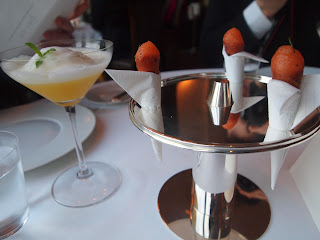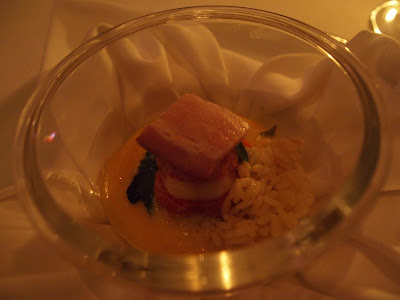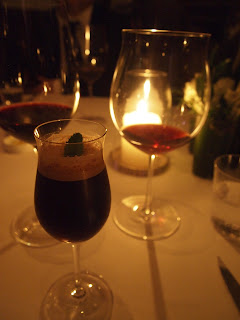New York City Review: Per Se
Per Se
10 Columbus Circle
4th Floor
New York, NY 10019
(+1) 212-823-9335
I returned to Per Se for my second dining experience- this time, with a friend who works there. I ate there back in 2009 but this time, I must say that I was more impressed and had the full Per Se experience. We arrived for our 7:30pm reservation and sat there indulging until 1:30pm. A six hour meal! Ridiculous.
Our meal started off with a special cocktail made for my friend. They told us we should come up with a name for it but we couldn't think of anything worthy of it. First time I ever saw synchronized service for cocktails...

Per Se's signature salmon tartare cornettes
It was a hot day so this Ajo Blanco was a perfect start to our six hour meal. The coriander blossoms added a nice touch. The garlic was not overpowering and the sweetness of the grapes was actually refreshing in this savory soup.
No meal at Per Se would be complete without Oysters and Pearls of course. A "sabayon" of pearl tapioca with Island Creek oysters and Sterling white sturgeon caviar. The perfect portion because it leaves you wanting just a little more.
Smoke- tartare of Australian Kampachi with the smoothest hass avocado puree you will ever come across. Served with granny smith apples and dashi pearls.
Soft Shell Crab Cocktail- one bite of San Marzano tomato marmalade, celery branch and preserved horseradish.
Pickled 100 Day Dry Aged American Wagyu- one of the most interesting dishes of the night for me. Very simple, served with cornichons and whole grain mustard. This pickled beef was smokey and tender.
Coddled Jidori Hen Egg- with caponata and roquette

Terrine of Hudson Valley Moulard Duck Foie Gras- with compressed strawberries and pickled ramps. Each one of us actually got a different foie gras dish.
Seven different salts and two different butters
Bili Bi- mussles in the half shell
Pave of Spanish Turbot- with English peas, pickled ramps, mizuna and applewood smoked bacon emulsion
Homard en Cocotte- Basmati rice, Vandouvan curry and kaffir lime. Didn't think I'd be eating basmati rice or any sort of curry at Per Se!
Hand Cut Tagliatelle- black winter truffles and parmigiano reggiano. Simple and delicious.
Four Story Hill Farm's Poussin en Croute de sel- with slow baked beets, celery ribbons, sauternes gelee and smoked foie gras
I had only slept three hours the night before and was actually starting to fall asleep with all the wine! So they thoughtfully made me a nice cold espresso drink :)
Elysian Fields Farm's Lamb Saddle en Crepinette- with arrowlead spinach "panade", Oregon morel mushrooms, braised fava beans and sauce Bordelaise
Maplebrook Farm's Burrata- with sungold tomatoes
Chocolate covered ice cream lolly
Strawberries and Cream- what a pretty dessert! Perfect balance of sweet and tart
Brownie and Malted Milk- double chocolate brownie, malted mousse, candied peanuts, maple bourbon ice cream and whipped crown maple syrup
Believe it or not we ate ALL these chocolates
Signature dessert of cappuccino semi freddo and doughnut (SO good)
Wine Accompaniment
Bollinger, "La Grande Annee" Ay 2002
Pichler-Krutzler, Riesling, "Loilennerg" Loibnerm Wachau 2010
Chateau Guirard, Sauternes 2001
Domaine Michel Niellon, Chassagne-Montrachet 2009
David Duband, Vosgne-Romanee 2009
Chateau d'Armailhac, Pauillac 2005
Domaine Morengo, "#655", Muscat du Cap Corse 2008
Labels: Columbus Circle, Fine dining, Manhattan, michelin star, new york, Oysters and Pearls, Per Se, Thomas Keller, Time Warner















































